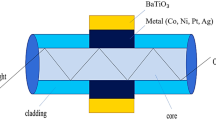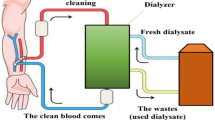Abstract
Water purity plays a key role in medical applications such as clinical diagnosis, drug delivery, sterilization, and patient management. One of the most important medical treatments in which the quality of water is very important is hydrotherapy. Most of the patients have weakened immune systems due to existing infections, making them highly vulnerable to new infections from contaminated water in hydrotherapy pools. Therefore, the hydrotherapy water should be tested to ensure the safety of the patients’ lives. In this research, a fiber optic bilayer sensor consisting of silver, copper, platinum, nickel, and gold as the metal layer, and scandium oxide as the second layer, has been numerically simulated to test water purity for hydrotherapy applications. The proposed configuration gives water purity detection with a maximum sensitivity of 4594.0°/RIU for Ni/Sc2O3 while the contacting length is considered as 10 mm, which is much higher than the conventional sensor. It is a topic of interest to researchers in related areas. Ag/Sc2O3 exhibits the highest figure of merit value compared to other materials. At the second part of the study, the effect of a silver-aluminum alloy has been investigated to enhance the quality factor of the winner structure (Ag/Sc2O3). The most efficient silver-aluminum combination ratio is found to be 0.1:0.9, which enhances the sensor quality factor from 40.50 to 60.45 (RIU−1) in aqueous media, while the refractive index of water changes from 1.33 to 1.34.












Similar content being viewed by others
Availability of Data and Materials
The data that support the findings of this study are available on request from the corresponding author.
References
Stewart BM (2000) The production of high-purity water in the clinical laboratory. Lab Med 31(11):605–611. https://doi.org/10.1309/5LMG-8DDL-GTE6-08F6
Burghart R (1996) The purity of water at hospital and at home as a problem of intercultural understanding. Med Anthropol Q 10(1):63–74. https://doi.org/10.1525/maq.1996.10.1.02a00070
Laroo H (2017) The fragile and flawed existence of questionable water purity as used in wet chemistry and in particular where such water is destined for medical applications such as vaccines. Int J Vaccines Vaccin 4(4). https://doi.org/10.15406/ijvv.2017.04.00087
Glorieux G, Neirynck N, Veys N, Vanholder R (2012) Dialysis water and fluid purity: more than endotoxin. Nephrol Dial Transplant 27(11):4010–4021. https://doi.org/10.1093/ndt/gfs306
Um-e-Kalsoom, Khan S, Ahmad I (2020) Impact of hemodialysis on the wellbeing of chronic kidney diseases patients: a pre-post analysis. Middle East Curr Psychiatry 27(1). https://doi.org/10.1186/s43045-020-00060-x
Castro-Sánchez AM, Matarán-Peñarrocha GA, Lara-Palomo I, Saavedra-Hernández M, Arroyo-Morales M, Moreno-Lorenzo C (2012) Hydrotherapy for the treatment of pain in people with multiple sclerosis: a randomized controlled trial. Evidence-based Complement Altern Med 2012. https://doi.org/10.1155/2012/473963
Chowdhury RS, Islam MD, Akter K, Sarkar MAS, Roy T, Rahman ST (2021) Therapeutic aspects of hydrotherapy: a review. Bangladesh J Med 32(2):138–141. https://doi.org/10.3329/bjm.v32i2.53791
Mooventhan A, Nivethitha L (2014) Scientific evidence-based effects of hydrotherapy on various systems of the body. N Am J Med Sci 6(5):199–209. https://doi.org/10.4103/1947-2714.132935
Esmailidastjerdipour P, Shahshahani F (2023) Quality enhancement of fiber optic surface plasmon resonance biosensor consisting of metal and barium titanate layer by using aluminum alloy in medical applications. Plasmonics. https://doi.org/10.1007/s11468-023-02013-6
Qu JH et al (2020) Expanding a portfolio of (FO-) SPR surface chemistries with the Co(III)-NTA oriented immobilization of His6-tagged bioreceptors for applications in complex matrices. ACS sensors 5(4):960–969. https://doi.org/10.1021/acssensors.9b02227
Esmailidastjerdipour P, Shahshahani F (2023) Numerical simulation of surface plasmon resonance optical fiber biosensor enhanced by using alloys for medical application. Sens Imaging 24(1):1–19. https://doi.org/10.1007/s11220-022-00409-y
Patel SK et al (2023) Terahertz metasurface-based refractive index sensor for amino acid detection: a numerical approach. IEEE Trans Nanobioscience 22:614–621. https://doi.org/10.1109/TNB.2022.3222446
Du B, Yang Y, Zhang Y, Yang D (2019) SPR label-free biosensor with oxide-metal-oxide-coated D-typed optical fiber: a theoretical study. Plasmonics 14(2):457–463. https://doi.org/10.1007/s11468-018-0824-1
Karki B, Salah NH, Srivastava G, Muduli A, Yadav RB (2023) A simulation study for dengue virus detection using surface plasmon resonance sensor heterostructure of silver, barium titanate, and cerium oxide. Plasmonics. https://doi.org/10.1007/s11468-023-01907-9
Jha R, Sharma AK (2009) High-performance sensor based on surface plasmon resonance with chalcogenide prism and aluminum for detection in infrared. Opt Lett. https://doi.org/10.1364/ol.34.000749
Karki B, Ramya KC, Sandhya Devi RS, Srivastava V, Pal A (2022) Titanium dioxide, black phosphorus and bimetallic layer-based surface plasmon biosensor for formalin detection: numerical analysis. Opt Quantum Electron 54. https://doi.org/10.1007/s11082-022-03875-6
Tabassum R, Gupta BD (2015) Surface plasmon resonance-based fiber-optic hydrogen gas sensor utilizing palladium supported zinc oxide multilayers and their nanocomposite. Appl Opt. https://doi.org/10.1364/ao.54.001032
Karki B, Ansari G, Uniyal A, Srivastava V (2023) PtSe2 and black phosphorus employed for sensitivity improvement in the surface plasmon resonance sensor. J Comput Electron 22:106–115. https://doi.org/10.1007/s10825-022-01975-w
Crisp J, Elliott B (2005) Introduction to fiber optics. https://doi.org/10.1016/B978-0-7506-6756-2.X5000-5
Singh TI, Singh P, Karki B (2023) Early detection of chikungunya virus utilizing the surface plasmon resonance comprising a silver-silicon-PtSe2 multilayer structure. Plasmonics 18(3):1173–1180. https://doi.org/10.1007/s11468-023-01840-x
Dostálek J, Kasry A, Knoll W (2007) Long range surface plasmons for observation of biomolecular binding events at metallic surfaces. Plasmonics. https://doi.org/10.1007/s11468-007-9037-8
Karki B, Jha A, Pal A, Srivastava V (2022) Sensitivity enhancement of refractive index-based surface plasmon resonance sensor for glucose detection. Opt Quantum Electron 54. https://doi.org/10.1007/s11082-022-04004-z
Kretschmann E (1971) Die Bestimmung optischer Konstanten von Metallen durch Anregung von Oberflächenplasmaschwingungen. Zeitschrift für Phys. https://doi.org/10.1007/BF01395428
Karki B, Uniyal A, Chauhan B, Pal A (2022) Sensitivity enhancement of graphene, zinc sulfide-based surface plasmon resonance biosensor with an Ag metal configuration in visible region. Comput Electron 21:445–452. https://doi.org/10.1007/s10825-022-01854-4
Zeng S, Baillargeat D, Ho HP, Yong KT (2014) Nanomaterials enhanced surface plasmon resonance for biological and chemical sensing applications. Chem Soc Rev. https://doi.org/10.1039/c3cs60479a
Esmailidastjerdipour P, Shahshahani F (2023) The optical fiber biosensor enhancement consisting of nanocomposite by using graphene in medical application. Plasmonics. https://doi.org/10.1007/s11468-023-02044-z
Karki B, Uniyal A, Pal A, Srivastava V (2022) Advances in surface plasmon resonance-based biosensor technologies for cancer cell detection. Int J Opt 2022. https://doi.org/10.1155/2022/1476254
Sharma AK, Kaur B (2018) Fiber optic SPR sensing enhancement in NIR via optimum radiation dam** catalyzed by 2D materials. IEEE Photonics Technol Lett. https://doi.org/10.1109/LPT.2018.2874700
Prabowo BA, Purwidyantri A, Liu KC (2018) Surface plasmon resonance optical sensor: a review on light source technology. Biosensors. https://doi.org/10.3390/bios8030080
Mukhtar WM, Halim RM, Dasuki KA, Rashid ARA, Taib NAM (2018) Silver-graphene oxide nanocomposite film-based SPR sensor for detection of Pb2+ ions. https://doi.org/10.1109/SMELEC.2018.8481315
Gupta BD, Sharma A, Singh CD (1993) Evanescent wave absorption sensors based on uniform and tapered fibres. A comparative study of their sensitivities. Int J Optoelectron
Rani M, Shukla S, Sharma NK, Sajal V (2014) Theoretical study of nanocomposites based fiber optic SPR sensor. Opt Commun. https://doi.org/10.1016/j.optcom.2013.10.048
Singh S, Gupta BD (2010) Simulation of a surface plasmon resonance-based fiber-optic sensor for gas sensing in visible range using films of nanocomposites. Meas Sci Technol. https://doi.org/10.1088/0957-0233/21/11/115202
Fu H, Zhang S, Chen H, Weng J (2015) Graphene enhances the sensitivity of fiber-optic surface plasmon resonance biosensor. IEEE Sens J. https://doi.org/10.1109/JSEN.2015.2442276
Socorro-Leránoz AB, Santano D, Del Villar I, Matias IR (2019) Trends in the design of wavelength-based optical fibre biosensors (2008–2018). Biosensors and Bioelectronics: X. https://doi.org/10.1016/j.biosx.2019.100015
Shukla S, Sharma NK, Sajal V (2016) Theoretical study of surface plasmon resonance-based fiber optic sensor utilizing cobalt and nickel films. Brazilian J Phys. https://doi.org/10.1007/s13538-016-0406-7
Tabassum R, Gupta BD (2017) Influence of oxide overlayer on the performance of a fiber optic SPR sensor with Al/Cu layers. IEEE J Sel Top Quantum Electron. https://doi.org/10.1109/JSTQE.2016.2553442
Ma H, Liu X, Gao C, Yin Y (2020) The calculated dielectric function and optical properties of bimetallic alloy nanoparticles. J Phys Chem C. https://doi.org/10.1021/acs.jpcc.9b11154
Gupta BD, Sharma AK (2005) Sensitivity evaluation of a multi-layered surface plasmon resonance-based fiber optic sensor: a theoretical study. https://doi.org/10.1016/j.snb.2004.08.030
Mishra AK, Mishra SK, Gupta BD (2015) SPR based fiber optic sensor for refractive index sensing with enhanced detection accuracy and figure of merit in visible region. Opt Commun. https://doi.org/10.1016/j.optcom.2015.01.043
Afsharnia M, Hamidi SM (2018) Design and performance perspectives on fiber optic sensors with plasmonic nanostructures and gratings: a review. IEEE Trans Magn. https://doi.org/10.1109/TMAG.2017.2761754
Regatos D et al (2010) Au/Fe/Au multilayer transducers for magneto-optic surface plasmon resonance sensing. J Appl Phys. https://doi.org/10.1063/1.3475711
Tabassum R, Kant R (2020) Recent trends in surface plasmon resonance based fiber–optic gas sensors utilizing metal oxides and carbon nanomaterials as functional entities. Sens Actuators B Chem. https://doi.org/10.1016/j.snb.2020.127813
Meng QQ, Zhao X, Lin CY, Chen SJ, Ding YC, Chen ZY (2017) Figure of merit enhancement of a surface plasmon resonance sensor using a low-refractive-index porous silica film. Sensors (Switzerland). https://doi.org/10.3390/s17081846
Lokhande CD (1991) Chemical deposition of metal chalcogenide thin films. Mater Chem Phys 27(1):1–43. https://doi.org/10.1016/0254-0584(91)90158-Q
Chauvin A, Txia Cha Heu W, Tessier PY, El Mel AA (2016) Impact of the morphology and composition on the dealloying process of co-sputtered silver–aluminum alloy thin films. Basical Solid State Phys. https://doi.org/10.1002/pssb.201600604
Putkonen M, Nieminen M, Niinistö J, Niinistö L (2001) Surface-controlled deposition of Sc2O3 thin films by atomic layer epitaxy using β-diketonate and organometallic precursors. Chem Mater 13. https://doi.org/10.1021/cm011138z
Author information
Authors and Affiliations
Contributions
Parisa Esmailidastjerdipour and Fateme Shahshahani do all the research together. All of the authors read the final manuscripts.
Corresponding author
Ethics declarations
Ethical Approval
This research does not include human or animal subjects.
Competing Interests
The authors declare no competing interests.
Additional information
Publisher's Note
Springer Nature remains neutral with regard to jurisdictional claims in published maps and institutional affiliations.
Rights and permissions
Springer Nature or its licensor (e.g. a society or other partner) holds exclusive rights to this article under a publishing agreement with the author(s) or other rightsholder(s); author self-archiving of the accepted manuscript version of this article is solely governed by the terms of such publishing agreement and applicable law.
About this article
Cite this article
Esmailidastjerdipour, P., Shahshahani, F. Numerical Simulation of Fiber Optic Biosensor Consisting of Metal/Sc2O3 Enhancing by Using Aluminum Alloy for Hydrotherapy Applications. Plasmonics 19, 1443–1452 (2024). https://doi.org/10.1007/s11468-023-02086-3
Received:
Accepted:
Published:
Issue Date:
DOI: https://doi.org/10.1007/s11468-023-02086-3




